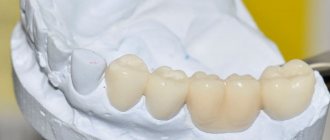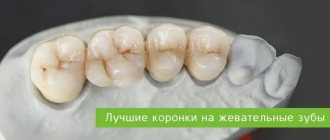Temporary dental crowns are crowns made from inexpensive materials that are used during prosthetics only to protect teeth until permanent crowns are installed.
The purpose of using temporary crowns is to strengthen teeth and give them a natural appearance.
Such crowns are not very stable and have limited aesthetics. They are installed on a previously ground tooth or on an implant.
In what cases are temporary crowns installed?
- When a tooth is chipped or completely lost.
- After root canal treatment.
- In the case where caries has led to weakening and destruction of the tooth crown.
- After implantation.
There are quite a few methods for restoring the beauty of a smile reliably and efficiently. However, almost all of them involve the manufacture of prostheses, which sometimes takes several days.
Installing a ceramic or metal-ceramic crown is a multi-step process that can take from several days to several weeks. What to do with the tooth prepared for permanent construction during this period? While the prosthesis is being made, it can be replaced by a temporary tooth. But often in the process of communicating with patients, we hear questions about the advisability of making temporary crowns, especially when an orthopedic dentist suggests placing a temporary crown for a short time before making a permanent structure.
Patients often wonder why temporary crowns are needed when they can just walk around with their teeth ground for a while. After all, such prostheses are installed only for the duration of orthopedic treatment, but require separate manufacturing.
Until recently, temporary crowns were not considered a necessity. However, over time, it became clear that their use significantly improves the quality of treatment and reduces the likelihood of complications after prosthetics.
The importance of using temporary structures has been proven by numerous studies. A high-quality temporary crown, made of materials with low thermal conductivity, protects the tooth pulp from external irritating factors. The main condition is that the crown must fit tightly to the boundaries of the tooth tissue to prevent saliva from getting under it.
In a healthy, intact tooth, the protective function lies on the enamel. However, in the process of preparing for prosthetics, this tissue is almost completely “cut down”. A tooth treated for a crown is exposed and vulnerable to various irritants (temperature, chemical). Therefore, in a ground tooth, a temporary crown takes on a protective role.
The temporary structure also has an occlusal function. It helps to chew normally and protects gum tissue from mechanical damage from food. In addition, a temporary crown ensures proper contact between teeth, preventing unwanted movements.
Many experts believe that the use of temporary crowns even prevents the development of pathologies of the joints and muscles of the maxillofacial area. It is also important that temporary structures maintain aesthetics during orthopedic treatment. This is especially true for the front teeth.
Usually, before installing a crown or prosthesis, the tooth needs to be ground, and only after grinding can impressions be taken and the manufacture of dentures begin. A ground tooth looks very unsightly and causes both aesthetic and psychological discomfort to the patient.
To restore the aesthetics and functionality of the dentition, temporary, or provisional, crowns are used.
They are especially relevant for the front teeth. However, plastic crowns not only mask visual defects in the dentition.
Functions of temporary crowns
• Temporarily restore the function of the ground tooth;
• Allows you to maintain normal diction;
• Do not allow infection to enter the tissues of the prepared tooth;
• Prevent gum tissue from growing onto the tooth to ensure normal installation of a permanent crown;
• Allow a person to quickly get used to a permanent crown;
• Firmly fix the tooth and prevent it from moving to the sides or staggering;
• Maintains bite, preventing neighboring teeth from taking up free space;
• If a tooth is ground down without removing the nerve, it becomes very sensitive to temperature and chemical stimuli, which can cause pain. A temporary crown protects such a tooth.
What are temporary crowns made of?
Temporary structures are made by a dental technician from monomer plastic in the laboratory or from monomer-free (hypoallergenic) composite plastic by an orthopedic dentist in a clinic. Special fast-hardening plastic is characterized by an external resemblance to the color and texture of natural teeth, because it, like ceramics or filling material, is selected according to color and shape. The temporary structure in the oral cavity looks so natural that many people around you may not notice that you are currently at the stage of prosthetics from an orthopedic dentist. Plastic also has high strength values, which makes it possible to make crowns from it for both front and side teeth. Before metal-ceramic crowns became widespread in dental practice, doctors widely used prosthetics using plastic.
For a temporary structure, fast-hardening dental resin is an ideal material - durable, aesthetic and cheap.
Disadvantages of temporary crowns
Temporary crowns are made very quickly and are quite convenient, but they have a number of disadvantages.
It is because of these shortcomings that they cannot be used as permanent prostheses:
• The material of the temporary crown is porous, which makes it easy for infection to penetrate. If the patient neglects the rules of hygiene, the pathogenic microflora will easily reach the ground tooth, which will lead to the development of an inflammatory process. In addition, even with careful hygiene, harmful substances gradually accumulate in the temporary crown;
• Temporary crowns change color very easily when exposed to certain drinks or foods, such as wine, coffee, strong tea, berries, etc. However, it will not be possible to whiten the temporary crown;
• A temporary crown is not strong enough, it has a very short service life and will simply break over time.
Service life of temporary crowns.
With temporary crowns, a person can walk for quite a long time (from several days to 4-5 months), but not constantly. It is worth remembering that any plastic is a very hygroscopic material that absorbs moisture and pigments well, as a result of which it swells and changes color. Plastic crowns are not intended for constant wear: as practice has shown, this does not lead to anything good. Teeth permanently covered with plastic crowns are destroyed and must soon be removed.
How to care for temporary crowns?
You must remember to follow some rules for caring for temporary structures in the oral cavity. This will help avoid its de-cementing (the appearance of mobility):
- Distribute the load on the teeth so that it is minimal on the side of the temporary crown.
- Avoid eating sticky or hard foods to avoid dislodging or damaging the temporary crown.
- Brush your teeth gently and thoroughly with a medium-hard toothbrush.
- When using dental floss to clean between teeth, do not pull it out, holding both ends with your fingers and pulling the thread down. It’s better to let go of one of its ends and slowly pull the end remaining in your hand away from your face.
- Do not wear the crown for more than the period recommended by your doctor!
Thus, the use of temporary crowns is a necessary intermediate step for the patient himself in any type of prosthetics.
Why are temporary crowns needed?
Before installing a permanent crown on a tooth, you must wait until the mucous membrane has healed. To protect the oral cavity from bacterial infections during this time, temporary crowns were created.
The dentist places a crown, which is bonded to the tooth with special temporary cement so that it can be easily removed when the final crown is ready.
Why is it necessary to put a temporary crown on your teeth?
- A temporary crown protects the ground tooth and ensures patient comfort while ensuring proper aesthetics.
- Preserving the aesthetics of a smile. Temporary crowns are especially often used to cover missing front teeth.
- Protection against hypersensitivity. A ground tooth without enamel protection is sensitive to the pain of temperature changes.
- Bite stabilization. A temporary crown prevents the remaining teeth from shifting.
- Protection of periodontal tissues. A temporary crown is necessary to prevent gingivitis.
- Protection against bacteria arising in the oral cavity.
How to make
There are two methods for making temporary crowns: direct and indirect. The production method largely depends on the indications and wishes of the patient. The indirect method is much more expensive, but this crown is stronger and lasts longer.
Direct manufacturing steps:
- taking an impression of the jaw;
- preparation and grinding of the natural crown and possibly adjacent teeth;
- casting a product from a material according to a cast;
- installation and adjustment of the crown;
- fixing the product with cement.
This method is recommended by dentists if treatment is not planned and it is necessary to protect the tooth from external factors and stress.
The entire procedure takes about two hours.
Installation of a temporary crown
The placement of a temporary crown is usually completed in one visit to the dental office. The installation process takes about 10-30 minutes. The procedure is painless. Grinding and correction of teeth are performed under local anesthesia.
First, the dentist prepares the tooth for a permanent crown. The tooth surface is ground down approximately 1-2 mm on each side.
Impressions of the teeth are then created. They are sent to a dental prosthetics laboratory, where permanent crowns are created.
While they are being made, the patient is given a temporary plastic crown. Once the dentist has received the finished permanent crown, he places it on the patient's tooth.
During the first days after the procedure, the patient may feel discomfort because the shape of the tooth with a temporary crown may be slightly different from what it was before.
Possible complications and side effects after the procedure:
- Discomfort
- Tooth sensitivity
- Allergic reaction
Making a dental crown in a dental laboratory.
After completing the medical stages, a fighter on the invisible front for the patient—the dental technician—comes into action. The resulting impressions are sent to the dental laboratory, where the actual production of the crown itself takes place. Schematically it looks like this:
— an impression technician casts a plaster model
— the frame of the future crown is modeled from wax on the treated tooth
— the wax frame is melted into metal (in the case of making a metal-ceramic crown) or transferred to a zirconium dioxide/lithium disilicate frame to make a metal-free crown (more on this in part two)
— then the technician applies layer-by-layer ceramic mass to the frame, which initially looks like thick sour cream, and after baking in a special oven takes on a “human” appearance. At the same time, the technician tries to the best of his ability to give the crown the desired anatomical shape and the desired color.
Tips for using temporary crowns
- Some foods will stick to the temporary crown, so please avoid chewing gum or other sweets and foods.
- Avoid chewing on the side of your jaw where the temporary crown was placed.
- Try to minimize your consumption of hard foods (such as vegetables), which can break the crown.
- Temporary crowns do not last long. Sometimes they may crack, break or fall out. If this happens to you, please contact us immediately, bring the crown with you, we will reinstall it or replace it.
- Do not remove the temporary crown from your mouth. Without it, your teeth may shift and the target crown may not fit.
- Don't brush too hard on a tooth with a temporary crown, and be careful with floss.
Indirect method
The indirect manufacturing method of crowns involves obtaining a high-quality product that has a more aesthetic appearance and is characterized by significantly increased reliability indicators. The cost of such a product will be higher.
Making individual temporary crowns using the indirect method takes up to two days. The process takes place in three stages:
- taking a silicone impression;
- making a plaster jaw model;
- casting a polymer crown;
- correction of the product using a plaster model using modern technologies.
Models of temporary crowns when manufactured indirectly correspond to the anatomical features of the dentition, so they do not cause discomfort and problems with chewing food.
Rules for wearing, care and adaptation
Temporary prosthetics are created very quickly and are not highly accurate, and naturally, the patient may feel some discomfort after its installation. Most often, such a prosthesis will interfere a little when closing the jaws. It is recommended that you tell your doctor about all the inconveniences, who will make adjustments and make it more comfortable and convenient.
Since temporary cement is used for fixation, the provisional prosthesis is not very securely fixed in the oral cavity. Therefore, to protect it (and the tooth itself), some precautions should be taken:
- avoid eating “stretchy” foods: toffees, chewing gum, etc.,
- reduce the chewing load on the temporary prosthesis: it is better to chew food on the opposite side,
- avoid eating solid foods
- Carry out hygiene procedures with caution: use threads especially carefully. An irrigator that gently and efficiently removes pieces of food from the interdental spaces will be a good help.
Features and Application
Installing temporary structures allows you to solve the following problems:
- masking the stump during the manufacture of a permanent prosthesis;
- maintaining the aesthetics and functionality of the row;
- eliminating the risk of displacement of adjacent units, between which there is an increased space after preparation and turning;
- overgrowth of soft tissues after removal of a damaged tooth is prevented;
- relief of pain and discomfort during the production of a permanent prosthesis.
Temporary crowns made of PMMA material are indicated for installation in the following cases:
- elimination of various aesthetic problems;
- restoration of chewing function;
- prevention of the development of bite problems;
- acceleration of the rehabilitation process, getting used to the artificial tooth;
- obstacle to mechanical damage;
- eliminating problems such as diction disorders;
- protection of the stump from temperature, chemical and other irritants;
- exclusion of mechanical and other damage.
Contraindications:
- bruxism;
- age (not used for children);
- in case of allergic reactions to the plastic used;
- deep bite
Materials
Synthetic polymethyl methacrylate is used for production. It is suitable for long-term wearing, making bridges and single-piece appliances. At the same time, production requires minimal time, the design is strong and reliable. No complex equipment is required; with the direct method, all actions require a minimum of time, that is, production occurs in one step.
Features of the material include the following properties:
- natural look, shine, surface polishing to give naturalness;
- biological compatibility;
- the cost of the design is affordable;
- increased aesthetics, the ability to restore the exact shape of a lost unit.
Why did they do this before?
Metal-ceramic crowns are quite expensive, and certain problems with them can only be discovered during a certain period of their use.
For example, while chewing food, the patient will feel discomfort; it is comfortable to chew on one side, but not on the other, although at first he did not notice this. The color of the crowns may be pleasant in the doctor’s office, but in other lighting, for example, on the street, it may not be as good as the rest of the teeth and will have to be corrected.
Often, for subjective reasons, it is necessary to redo the crown, the removal of which when installed with permanent cement presents a certain difficulty
Often, after installing prostheses, others may not even notice how much money was invested in their purchase. This can hurt and upset women. Remarks from others that the teeth are too small or, conversely, very large can force you to run to the doctor again to have everything redone. But these phrases can only be said out of envy, but some will take them calmly, while others will rush to correct everything.
Therefore, if the cement is temporary, then removing and redoing the crowns, adjusting the shape, changing the shade and installing them again will not be difficult. If the cement is already permanent, then the crowns are cut, thrown away, and their production and prosthetics begin again from the very beginning. Although this rationale for using initially temporary cement is understandable, this approach has long been outdated.
With the use of modern techniques in the installation of crowns and prosthetic structures, temporary cement is no longer used.











